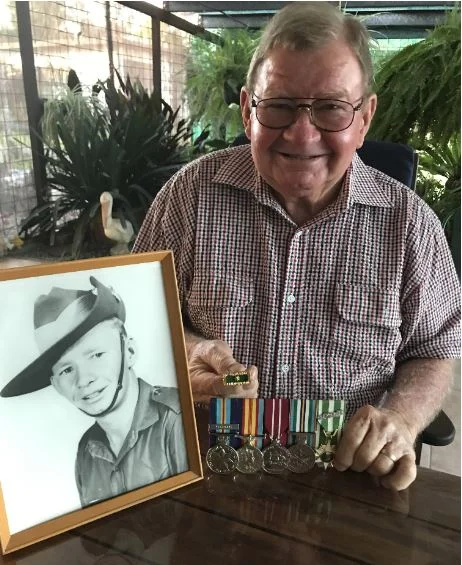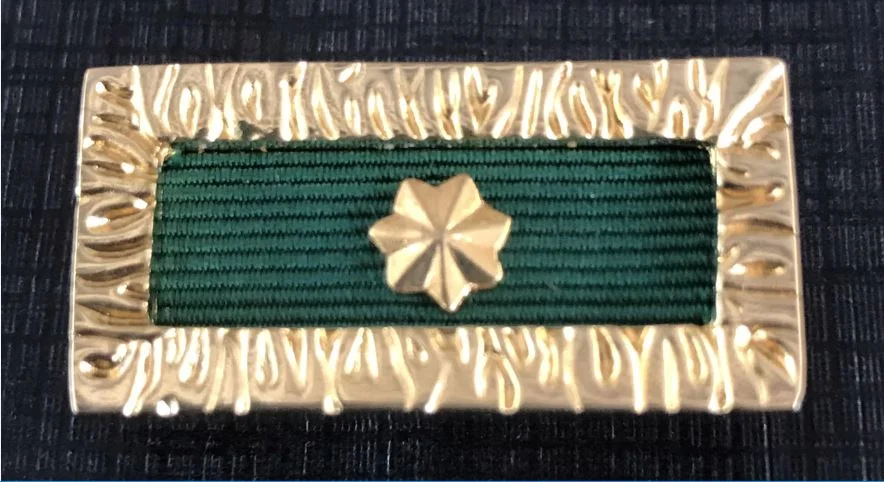Remembering Vietnam: Thangool National Serviceman awarded Unit Citation Gallantry Badge
by Kathy Dumbleton
Vietnam Veteran Mick Kurtz with his service medals, including in his hand the Unit Citation Gallantry Badge.
Mick Kurtz was just 20 when he was called up for National Service to fight in Vietnam.
He was the only Thangool resident at the time to be called up by the national service lottery, receiving notification by mail in October 1967. It seemed history would repeat as Mick’s father Norman Kurtz had fought in World War Two.
Mick caught the train from Gladstone that would begin his journey into military life.
“The troop train came all the way down from Cairns, and we had one night at Enoggera Barracks in Brisbane before being bussed to Singleton,” Mick recalls.
“It was a rotten trip, they weren’t buses like they are today!”
For the next three months Mick would be based at the Singleton training camp, part of two full companies of National Servicemen.
While they were given a choice which corps they preferred, not all were allocated their choice and troops were sectioned off where they were required.
It so happened they were short in artillery, and for the next three months Mick would be stationed at the School of Artillery, North Head, Sydney.
This would provide a crash course in artillery and radio before being transferred to 12th Field Regiment Artillery at Holsworthy Barracks in Sydney before being sent on to Canungra, above the Gold Coast, for jungle training.
This jungle field exercise was to simulate the conditions the young troops would experience, including ambush and live firing.
“One part of the training course had a machine gun with a fixed line firing live ammo,” Mick said.
“We had to jump into the water in full pack and clothes whether you could swim or not!”
After this training, the servicemen were given 10 days of leave to see their families before heading overseas.
Mick said goodbye to his parents at the Thangool Airport at the end of April 1968 en route to Sydney and Holsworthy Barracks, and eventually Saigon.
“The flights from Sydney Airport would leave at 12 midnight to dodge the possibility of protestors,” Mick remembers.
“All I saw of Saigon was the airport. There were jets and planes taking off every two seconds.
“We stepped off the plane and straight onto a Caribou to Nui Dat, the Australian Army base.
“After 10 days we were told to pack our gear up, nobody knew where to. After a night at Longbinh, an American airbase, we were choppered out into the jungle to help set up a Fire Support Base, Coral.”
No amount of training would prepare the young soldiers of Headquarter and 102 Battery 12th Field Regiment for the onslaught at the Battle of Coral and Balmoral.
Mick distinctly remembers walking through the six foot tall grass then being told to start digging.
“We had to dig ourselves a shell scrap,” Mick remembers.
Mick and his friend Terry Lee dug theirs together, while small dozers were brought in to dig the command post and protective bunds around the guns.
At 2am on the 13 th of May 1968, the North Vietnam Army (NVA) hit. Mick recalls hearing the command over the radio:
“Stay where you are.”
A company of infantry were supposed to be in front of Mick’s battery, but they never arrived.
“We only had a section of mortars from 1RAR. During the battle the NVA captured number 6 gun, a 105 mm howitzer of 102 Battery.”
Of all the battles Australians fought in Vietnam, this would go down in history as the longest lasting and most costly.
“We lost two mates KIA [killed in action] that night, Chris Sawtell and Ian Scott, and four were wounded from Headquarter Battery.”
The battle lasted until daybreak, when the resilient troops of the 12th Regiment dug in, put up barbed wire and the infantry arrived early the next morning.
“The first night was the worst,” Mick recalls.
“The local boozer was named after the two men we lost – The Scott Sawtell Club.”
The strong connection and mateship the troops would share over the course of the next 10 months would cement life long friendships. Mick’s jovial attitude around the base on one particular off duty rotation would end in him being charged.
“I was at the boozer with the Yanks. I was three sails to the wind and went to see me mate at the command post to take him a packet of biscuits,” Mick smiled. “Probably wasn’t the best idea!”
He was caught by his Duty Sergeant, fined $10 and confined to barracks for a week . The punishment was a week’s ‘dixie bashing’ or washing up in the officers’ mess.
“The officer was almost smiling as he read out the charge.”
“Armed with a packet of biscuits!”
Mick was officially discharged on January 21st, 1970: two years and 111 days since enlistment, and 309 days stationed in Vietnam.
When his tour was over he went home to Thangool, but he never forgot the mates he served with.
The first of the welcome home parades was held in Sydney in 1987. This was the first opportunity Mick had to catch up with his soldier mates.
“It was like picking up where we left off,” Mick said. “It was like we hadn’t stopped talking since the last time we met.”
Mick Kurtz’ Unit Citation Gallantry Badge.
On May 12 and 13 2018, Mick and his wife Lorelle were invited to special commemorative services in Canberra to mark the 50th anniversary of the Battle of Coral and Balmoral.
Mick and his fellow veterans were awarded the Unit Citation for Gallantry, recognising the bravery of all members who fought in that battle. This recognition was a long time coming for these veterans, and was acknowledged with a Unit Citation Gallantry Badge.
Mick will add the commemorative badge to his service medals, and wear it proudly this Anzac Day.
Open Arms Veterans & Families Counselling Service (formerly VVCS) provides free, confidential counselling and support for current and former ADF members and their families. You can call them 24/7 on 1800 011 046 or visit their website.
The Department of Veterans’ Affairs provides immediate help and treatment for any veteran with a mental health condition, whether it relates to service or not. To find out more or seek help for yourself or someone you know, call Open Arms on 1800 011 046 or DVA on 1800 555 254, or visit the DVA website.






